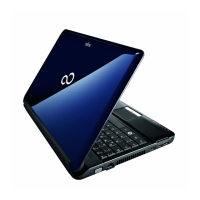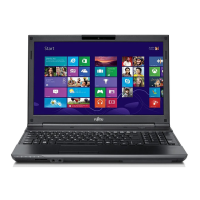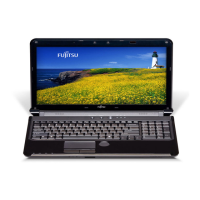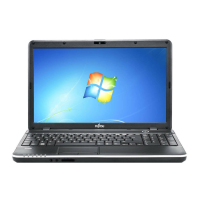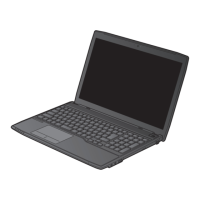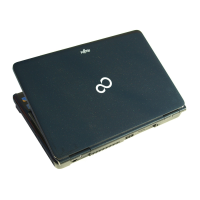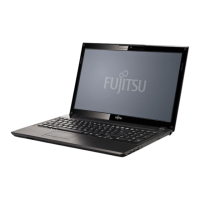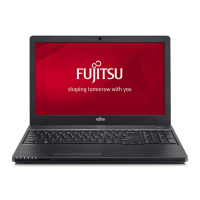What to do if Previous boot incomplete error occurs on Fujitsu Lifebook AH531 Laptop?
- SSandra QuinnSep 23, 2025
Press the F1 function key when prompted to do so.
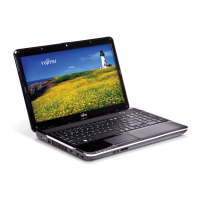
What to do if Previous boot incomplete error occurs on Fujitsu Lifebook AH531 Laptop?
Press the F1 function key when prompted to do so.
How to turn on WLAN on Fujitsu Lifebook AH531 Laptop?
To activate wireless LAN on your Fujitsu Laptop, press the [Fn] and [F5] keys simultaneously. The wireless LAN indicator will light up when active. Repeat the same step to turn it off. This is because the wireless device functions may have been disabled.
How to resume Fujitsu Lifebook AH531 from Standby mode?
To resume your Fujitsu Laptop from Standby mode, push the Power/Suspend/Resume button.
What to do if my Fujitsu Laptop stops working?
If your Fujitsu Laptop stops working, it may be in energy-saving mode, so leave energy-saving mode. It is also possible that an application programme has caused the malfunction. In this case, close the application program or restart the notebook. Finally, ensure that the battery is charged or connect the mains adapter, as a dead battery could be the cause.
How to fix the LCD screen if it is difficult to read on Fujitsu Lifebook AH531?
If the LCD screen on your Fujitsu Laptop is difficult to read, it could be due to reflected glare, so try turning the notebook or altering the tilt of the LCD screen. Additionally, increase the brightness of the screen.
What to do if Extended memory failed at offset on Fujitsu Laptop?
Check whether the additional memory module has been inserted correctly.
What to do if a beep sounds every few seconds on my Fujitsu Lifebook AH531?
If a beep sounds every few seconds on your Fujitsu Laptop, charge the battery.
What to do if radio connection to a network does not work on Fujitsu Lifebook AH531 Laptop?
If the radio connection to a network does not work on your Fujitsu Laptop, switch the radio component on. If the wireless component is enabled but the connection still doesn't work, check whether the radio connection is switched on via the software.
Why ExpressCard doesn't work on Fujitsu Lifebook AH531 Laptop?
If an ExpressCard in your Fujitsu Laptop isn't working, it might not be properly installed. Try removing and reinstalling the card. If that doesn't work, close any running applications and restart your notebook. Also, ensure you have the correct driver active by checking your software documentation.
Why does my Fujitsu Lifebook AH531 turn off by itself?
If your Fujitsu LIFEBOOK notebook turns off unexpectedly, there could be several reasons: * **Battery Failure:** Check the battery condition using the Status Indicator panel and replace it if it's shorted. * **Power Adapter Issues:** Ensure the adapter is properly plugged in and the outlet is working. * **Low Battery:** If operating on battery, connect a power adapter and press the Power/Suspend/Resume button, as the system may have entered Dead Battery Suspend mode.
| Processor | Intel Core i3/i5/i7 |
|---|---|
| RAM | Up to 8 GB DDR3 |
| Chipset | Intel HM65 Express |
| Optical Drive | DVD Super Multi |
| Webcam | 1.3MP |
| Wireless LAN | 802.11b/g/n |
| Bluetooth | Bluetooth 3.0 |
| Battery | 6-cell Lithium-ion |
| Display | 15.6-inch HD (1366x768) |
| Storage | 320GB, 500GB, or 750GB HDD |
| Graphics | Integrated Intel HD Graphics |
| Operating System | Windows 7 Home Premium |
| Weight | 2.5 kg |
| Card Reader | SD/SDHC/SDXC |
| LAN | 10/100/1000 Mbps Ethernet |
| Ports | 3 x USB 2.0, 1 x USB 3.0, 1 x HDMI, 1 x VGA |
Provides an overview of the manual's content and purpose.
Explains formatting and symbols used throughout the manual.
Details how to contact Fujitsu for service and support.
Introduces the Fujitsu LIFEBOOK AH531 notebook and its features.
Identifies and describes the various ports and components on the notebook.
Brief description of the notebook's top-mounted components.
Brief description of the notebook's left-side panel components.
Brief description of the notebook's right-side panel components.
Brief description of the notebook's bottom panel components.
Explains the meaning of the various status LEDs on the notebook.
Describes the LED for wireless network status.
Describes the LED for power status and AC adapter connection.
Explains the LED that shows the battery charge level.
Explains LEDs for hard drive and optical drive activity.
Explains LEDs for Num Lock and Caps Lock states.
Details the notebook's power sources and how to connect adapters.
Step-by-step guide to connecting AC and Auto/Airline adapters.
Information on opening, adjusting, and closing the display panel.
Instructions on how to open the notebook's display.
Methods for adjusting the screen brightness.
Instructions on how to close the notebook's display.
Guides on powering on, booting, and initial setup.
How to turn on the notebook using the power button.
Explanation of the notebook's startup process.
Information on setting up HDD passwords via BIOS.
How to enter and use the BIOS setup utility.
Steps for the initial system startup.
Guidance for the first-time Windows setup.
Instructions for running the ClickMe! setup utility.
How to use the utility for updating system drivers.
Information on the notebook's battery, its care, and replacement.
How to recharge the notebook's Lithium ion battery.
Step-by-step guide for cold and hot-swapping batteries.
Details about the optical drive and loading/ejecting media.
Information on using the notebook's media player.
Instructions for inserting discs into the optical drive.
Steps for removing discs from the optical drive.
How to open the media tray if the eject button fails.
Information on installing and using ExpressCards.
Details on using memory cards like SD and Memory Stick.
Instructions for inserting memory cards into the slot.
Steps for removing memory cards from the slot.
Guides on installing and removing memory modules.
Step-by-step instructions for upgrading system memory.
Instructions for removing installed memory modules.
How to verify the system recognizes the memory upgrade.
General guide to identifying and resolving common notebook issues.
Procedure for diagnosing issues before complex troubleshooting.
Lists common problems and their potential causes/solutions.
A table of problems, causes, and solutions for quick reference.
Steps for creating and restoring system backups and factory images.
Instructions on how to back up the factory image to DVD.
Guide to creating various types of system backup images.
Detailed steps for restoring the original factory image.
Explains error and status messages from the BIOS POST.
General tips for maintaining the notebook's longevity and reliability.
Guidelines for cleaning the notebook's exterior, keyboard, and display.
Recommended methods for disinfecting the notebook's surface.
Proper procedures for storing the notebook for extended periods.
Advice on safely transporting the notebook.
Information on battery care, charging, and increasing battery life.
Best practices for handling and maintaining batteries.
Tips and settings to maximize notebook battery performance.
Guidelines for caring for optical media and the drive.
Proper handling and storage of optical discs.
Recommendations for maintaining the optical drive.
Advice on caring for various types of memory and expansion cards.
General guidelines for handling and storing memory cards.
Overview of the notebook's hardware and environmental specifications.
Explains how to read the notebook's configuration label.
Details about the notebook's CPU.
Information on the notebook's chipset.
Specifications for system memory and cache.
Details on the display panel's resolution and color capabilities.
Specifications for the notebook's audio system.
Information on hard drive and optical drive options.
Lists integrated features like touchpad and webcam.
Specifications for LAN, Wireless LAN, and Bluetooth.
Details all available ports on the notebook.
Specifications related to the notebook's keyboard.
Information on the battery and AC adapter.
Physical dimensions and weight of the notebook.
Operating and non-operating temperature and humidity limits.
Introduces the wireless LAN device and its setup procedures.
Lists the specific WLAN devices applicable to this guide.
Describes the technical characteristics of the WLAN device.
Explains different operating modes for the wireless LAN.
Details the peer-to-peer Ad Hoc wireless network configuration.
Explains the infrastructure mode for wireless networking.
Notes on potential interference and usage restrictions for WLAN.
Procedures for disabling and disconnecting the WLAN.
Steps for configuring wireless network connectivity in Windows.
Detailed steps for setting up WLAN via Windows Control Panel.
How to connect to an active wireless network.
Guidance for resolving common wireless LAN issues.
A table of WLAN problems, causes, and solutions.
Technical specifications for the Wireless LAN device.
Explains Bluetooth technology and its applications.
Guides on accessing Bluetooth help and web resources.
Introduction to Intel Wireless Display (WiDi) technology.
Steps to launch and use the Intel Wireless Display application.
